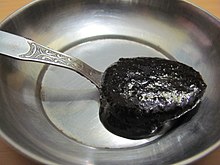Chyavanprash: Difference between revisions
Unhelpful edit Tags: Manual revert Mobile edit Mobile web edit |
Added important information about the ingredients. |
||
| Line 52: | Line 52: | ||
* Wild [[black gram]] |
* Wild [[black gram]] |
||
* Wild [[green gram]] |
* Wild [[green gram]] |
||
{{div col end}}All leading market brands of Chyavanprash are shown to contain about 6 [[Mass fraction (chemistry)|wt%]] of [[heavy metals]] including [[Mercury poisoning|Mercury]].<ref>{{Cite journal|last=Sharma|last2=Martins|last3=Kuca|last4=Chaudhary|last5=Kabra|last6=Rao|last7=Prajapati|date=2019-04-26|title=Chyawanprash: A Traditional Indian Bioactive Health Supplement|url=https://www.mdpi.com/2218-273X/9/5/161|journal=Biomolecules|language=en|volume=9|issue=5|pages=161|doi=10.3390/biom9050161|issn=2218-273X|pmc=PMC6571565|pmid=31035513}}</ref> |
|||
{{div col end}} |
|||
==Market== |
==Market== |
||
Revision as of 16:37, 6 June 2021

Chyavanprash (also spelled chyavanaprasha, chyavanaprash, chyavanaprasam, chamanprash and chyawanaprash) is a cooked mixture of sugar, honey, ghee, Indian gooseberry (amla) jam, sesame oil, berries and various herbs and spices.[1] It is prepared as per the instructions suggested in Ayurvedic texts. Chyavanprash is widely sold and consumed in India as a dietary supplement.
Origin
Chyavanprash is an ancient formulation and product.[2] Various ancient Indian texts like Mahabharata, Puranas etc., relate that Ashwini Kumar brothers, the twins, who were Raja Vaidya (Royal Physicians) to Devas during Vedic times, first prepared this formulation for Chyavana Rishi at his Ashram on Dhosi Hill near Narnaul, Haryana, India, hence the name Chyavanprash.[3] The first historically documented formula for chyavanprash appears in the Charaka Samhita, the ancient Ayurvedic treatise[4] from the early first millennium BCE.
Taste and appearance
Chyavanaprash tastes sweet and sour at the same time. The taste is dominated by the flavors of honey, ghee (clarified butter) and amla, and the smell by ghee and other spices including sandalwood, cinnamon and cardamom.
Consumption
Chyavanaprash is usually consumed directly. It can also be consumed along with warm water.
Composition
The recipe of chyavanprash is mentioned in manuscripts written for ayurvedic method of treatment viz. Ashtangahridayam, Charakasamhita, Sangandharasamhita. Amla is a primary ingredient of Chyavanaprash which makes it rich in Vitamin C (445 mg/100g).[5] The number of herbs used may vary from 25 to 80 but the main ingredient of all Chyavanprash is amla.[6] Other chief ingredients are:
- ashwagandha (Withania Somnifera or Winter cherry)
- asparagus (Asparagus racemosa)
- amla
- bamboo manna
- blue Egyptian water lily (Makhana)
- cardamom
- chebulic myrobalan
- Chinese cinnamon
- cinnamon bark
- clove
- Indian rose chestnut
- country mallow
- feather foil plant (Phyllanthus niruri or Bhumiamalaki)
- galls
- ghee
- Giant potato (Ipomoea mauritiana or Kiribadu Ala)
- Giloy (Guduchi) (Tinospora cordifolia)
- honey
- Indian kudzu
- Irish root
- liquorice
- Long pepper (Piper longum)
- Malabar nut (Seed of Adhatoda vasica)
- Nut grass
- Potassium sorbate
- Raisins
- Round zedoary
- sandalwood
- sesame oil
- Spreading hogweed (Boerhavia diffusa)
- Sugar
- Tiger's claw or Ice plant (Erythrina variegata)
- Wild black gram
- Wild green gram
All leading market brands of Chyavanprash are shown to contain about 6 wt% of heavy metals including Mercury.[7]
Market
The market size of chyavanprash in 2010 was Indian Rs 4 billion (about $80 million USD). Chyavanprash in India is marketed through film stars and sports persons such as Amitabh Bachchan, Ramdev Baba, Shahrukh Khan, Ravi Kishan, Virendra Sehwag, and Mahendra Singh Dhoni.[8]
References
- ^ Vora, M.S. (2015). Rasayana: The Fountain of Life. Partridge Publishing India. p. 217. ISBN 978-1-4828-4315-6. Retrieved November 2, 2017.
- ^ Gupta, S.K. (2001). Pharmacology and Therapeutics in the New Millennium. Springer Netherlands. p. 332. ISBN 978-0-7923-7059-8. Retrieved November 2, 2017.
- ^ Panda, H; Handbook On Ayurvedic Medicines With Formulae, Processes And Their Uses, 2004, p10 ISBN 978-81-86623-63-3
- ^ Bates, D, Knowledge and the Scholarly Medical Traditions Cambridge University Press 1995, p325 ISBN 978-0-521-49975-0
- ^ Tarwadi K, Agte V (Aug 2007). "Antioxidant and micronutrient potential of common fruits available in the Indian subcontinent". Int J Food Sci Nutr. 58 (5): 341–9. doi:10.1080/09637480701243905. PMID 17558726.
- ^ Johnston, Robert (2004). The politics of healing : histories of alternative medicine in twentieth-century North America. New York: Routledge. p. 226. ISBN 0-415-93338-2.
- ^ Sharma; Martins; Kuca; Chaudhary; Kabra; Rao; Prajapati (2019-04-26). "Chyawanprash: A Traditional Indian Bioactive Health Supplement". Biomolecules. 9 (5): 161. doi:10.3390/biom9050161. ISSN 2218-273X. PMC 6571565. PMID 31035513.
{{cite journal}}: CS1 maint: PMC format (link) CS1 maint: unflagged free DOI (link) - ^ Economic Times SRK, Dhoni, Ravi Kishan do wonders for chyawanprash
